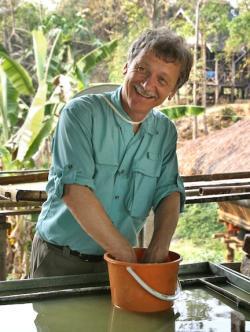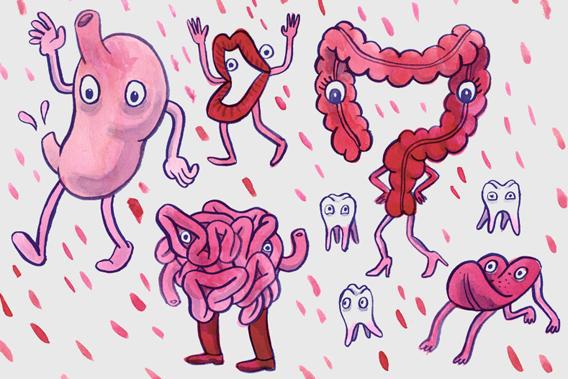Whether you feast on truffles or Cheetos, the end result is the same. Shit is the great leveler. There’s nothing more democratic or unpretentious than what happens in the confines of our commodes—as the children’s book reassures us, everybody poops. While we increasingly obsess over what we put in our mouth, we pay little mind to what becomes of our meals once they go down the hatch, at our own peril. Two new books encourage us to recognize ourselves in our most humbling bodily affairs.
“People are surprised to learn: They are a big pipe with a little bit around it,” says one of the many colorful scientists that populate Gulp, an odyssey through the digestive system by Mary Roach. Roach guides the reader gently down the upper reaches of the alimentary canal like a trustworthy gondolier before hitting the bawdy, chaotic rapids nearer the end of the journey.

Photo by Chris Hardy
Starting in the mouth, Roach skewers the maladaptive Western taste for protein-rich but nutritionally deficient animal parts—our preference for the bland comfort of a chicken breast over the complex, multivitamin-like offerings of liver, lungs, spleens, and brains that indigenous cultures still enjoy. In the mouth we meet scientists who have dedicated their lives to the mechanics of chewing and the chemical makeup of human saliva. (Our intuitions that saliva is a great stain-remover are confirmed: Saliva enzymes have been isolated and employed as active ingredients in high-end laundry detergents.)
Things get more exciting once we enter the stomach. Death by overeating, Roach informs us, is a real, if astronomically rare, phenomenon suffered not only by Monty Python characters but by gluttons with an affinity for postprandial alka-seltzers (the gas created by the antacids can be, in extreme circumstances, the straw that breaks the camel’s stomach).
But it is the characters we encounter along the way that make Gulp so much nauseating fun. In the ghoulish 19th-century tale of surgeon William Beaumont and his adopted test subject Alexis St. Martin, we find consolation for the dysfunctional relationships in our own lives. St. Martin was a French Canadian trapper who, thanks to a blast of duckshot to his gut, had an open hole in his abdomen that gave Dr. Beaumont easy access to the roiling inner-workings of his stomach. Beaumont’s experiments on the hapless Canuck were bizarre to say the least (“On applying the tongue to the mucous coat of the stomach, in its empty, unirritated state, no acid taste can be perceived.”)
But in Gulp, as with partly digested food, after the pyloric sphincter, the gateway to the small intestine, there’s no turning back. When Roach hits her stride in the intestines and onward, it’s exhilarating to watch her gleefully trespass every taboo thinkable—and some that likely never occurred to the prim imaginations of most readers: shit eating and its spurious cousin, defecation by mouth; holy water enemas; the superhuman feats of rectal flexibility performed by human drug mules and prison contrabandists; and fatally explosive flatulence, to name a few.
Some episodes read like Jackass skits recounted in the clinically understated style of19th-century physicians. Whether you will enjoy this book depends on your reactions to the following representative quotes. Roach pulls the first from the June 1874 Atlanta Medical and Surgical Journal as Dr. Robert Battey describes his great innovation in breaking up impacted masses in the colon, namely, injecting up to three gallons of water into the rectum: “So great was the abdominal tension that the water spouted from the anus when the pressure was removed in a bold stream,” more than two feet high.
An 1871 issue of the British Medical Journal (the 1870s were evidently a golden age for this sort of thing) suggests another treatment for intestinal blockages: the application of an electric current to a patient’s abdomen. “Efficacious?” a raffish physician is quoted in the Journal. “I could hardly get out of the way in time.”
On that subject Roach also offers up what would seem to be the definitive account of Elvis’ death. While it has the air of an urban legend, Roach settles the question of the King’s demise—death by constipation—at the same time warning this reader, at least, of the overlooked scourge of defecation-associated sudden death, the perhaps not-so-silent killer.
Every journey must end, though, and Roach’s voyage through the alimentary canal ends on a somewhat serious matter: the cutting-edge science behind the fecal transplant (what it sounds like) and the regulatory morass and squeamishness that hold back this apparently transformative procedure. Roach describes the almost miraculous relief of intestinal suffering experienced by patients infected with C. difficile—a potentially fatal condition that causes bouts of severe colitis and diarrhea. Thanks to the timely injection of someone else’s you-know-what, these patients’ bacterial gut flora is restored, as is their health. The clinical trial for treating C. difficile took a year and a half to gain approval from a university review board, and final FDA approval, the kind that would bring the procedure to the masses, could take more than a decade, Roach says.
Once we are safely out of the intestines, back into the light of day at the other end, David Waltner-Toews picks up the thread with his impassioned treatise on the long, strange, even transcendent afterlife of poop in The Origin of Feces, a book whose cover is guaranteed to make you few friends at the coffee shop.
First a note about nomenclature. Shit goes by many names, including the four-letter variety. Being corporeal creatures with regular bodily functions we have to talk about this taboo more than we’d like and, necessity being the mother of invention, there exists an almost unmatched taxonomic diversity of euphemisms that exist for poop. Steven Pinker, in The Stuff of Thought, rattled off at least 40, but Waltner-Toews adds a few more obscure entries, like exuviae, to go along with ordure, spraint, doo-doo, biosolids, night soil, roadapples, and of course humanure.

Courtesy of Jen Chan Firestone
A veterinarian and epidemiologist by training, Waltner-Toews asks us to stop snickering and grapple seriously with the implications of the 400 million metric tons of the stuff we homo sapiens produce every year. If you’re squeamish about scat, just remember: Jesus was responsible for two metric tons in his lifetime. Mohammed, who likely lived twice as long, was responsible for four. “Have a look in the toilet,” Waltner-Toews invites us, reminding us that our body sheds some of its billions of dead cells daily through defecation. “That’s not just a stool sample: that’s the old you. That’s life.”
For eons feces has served as a benign, even life-giving, agent in the world, fertilizing the earth, dispersing seeds, cycling carbon and generally making the planet work. In the animal world, it retains this benevolent reputation. African bushbucks send sexual signals with their droppings. Many animals, rabbits most notably, eat theirs, suffering nutritional deficiencies otherwise. “A deer doe,” Waltner-Toews writes, “will eat her fawn’s feces for the first month of life in order to avoid attracting predators. Funny, I don’t remember that from Bambi.”
We learn that by fertilizing the deep with iron-rich poop, sperm whales in the Antarctic Ocean are responsible for removing 200,000 metric tons of carbon dioxide from the atmosphere each year. Similar feats of carbon cycling are performed by schools of defecating fish. In fact, life on Earth owes its very existence to the metabolic waste products of ancient bacteria, and Waltner-Toews has fun with this inversion: “While anaerobic bacteria may be offended at the scent of oxygen farts passing from a bush, most of us relish the fresh scent of clean air in the woods at night.”
For humans, however, especially since they began aggregating in cities and carrying out petroleum-powered industrial agriculture on a massive scale (which is responsible for unimaginable quantities of waste), unprecedented amounts of poop are being concentrated in fewer places, Waltner-Toews warns, with threats to public health, the food supply and the diversity of life on earth. In the place of biodiverse ecosystems we raise monocultures of plants and livestock that we then ship to cities, where they are transformed to feces by humans, sent to sewage systems, and returned to the environment in a harmful concentrated form. The cycle that has replenished the planet for millennia has become a one-way degradation of one of our most valuable resources. Or, as the author puts it: “We are transforming a wonderful, complex planet into piles of shit.”
—
Gulp: Adventures in the Alimentary Canal by Mary Roach. W.W. Norton.
The Origin of Feces: What Excrement Tells Us About Evolution, Ecology, and a Sustainable Society by David Waltner-Toews. ECW Press.
See all the pieces in this month’s Slate Book Review.
Sign up for the Slate Book Review monthly newsletter.
